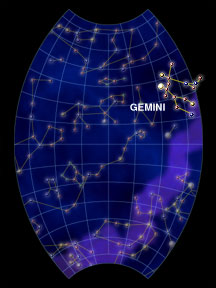The Constellation Cygnus, the Swan
Click on image for full size
Cygnus
Cygnus, the Swan, looks like a big cross. The tail of the swan is
marked by the bright star
Deneb. The head of the swan is a
star called Albireo, a star with a surprise! Three fainter stars
cross the line between Deneb and Albireo, making a "t" shape.
Both the tail and bill of the swan are special stars. Deneb is a
bright, blue star, and is only a few million years old - very young
for a star! What is Albireo's surprise? Albireo is actually two
stars, one yellow and one blue! Although with just your eyes you only
see one star, you can see that there are really two if you look
through a small telescope.
The ancient Greeks may have called these stars a swan to honor the
great musician Orpheus. Orpheus loved his harp, Lyra, very much so he was transformed and set in
the sky to be near it.
You might also be interested in:

How did life evolve on Earth? The answer to this question can help us understand our past and prepare for our future. Although evolution provides credible and reliable answers, polls show that many people turn away from science, seeking other explanations with which they are more comfortable.
...more
What's in a Name: Arabic for "tail" because it is located in the tail of the Cygnus, the Swan. Claim to Fame: 19th brightest star in the sky (apparent visual magnitude = 1.3) Type of Star: White Supergiant
...more
It seems the sky is filled with mythical people and animals. But now meet the one and only musical instrument to grace the sky: Lyra, the Lyre! A lyre is a small harp, small enough to fit in your lap.
...more
The constellation Gemini is really a set of twins! If you live in the Northern Hemisphere, you can see Gemini in the winter and spring. If you live in the Southern Hemisphere, you can see it in the summer
...more
For the ancient Greeks, the constellation Cygnus, which means "swan", was related to the myth of Zeus and Leda, the queen of Sparta. The queen of sparta was so beautiful that Zeus was attracted to her.
...more
For the ancient Greeks, the constellation Cygnus, which means "swan", was related to the myth of Zeus and Leda, the queen of Sparta. The queen of Sparta was so beautiful that Zeus wanted her. After numerous
...more
For the ancient Greeks, the constellation Cygnus, which means "swan", was related to the myth of Zeus(for Romans, Jupiter) and Leda, the queen of Sparta. The queen of Sparta was so pretty that Zeus fell
...more
In Roman mythology, the constellation Cygnus, which means "swan", was related to the myth of Jupiter and Leda, the queen of Sparta. The queen of Sparta was so pretty that Jupiter fell in love with her.
...more













